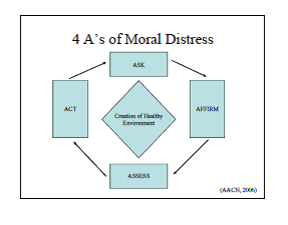By Rose O. Sherman, EdD, RN, FAAN
“Our lives begin to end the day we become silent about things that matter” -Martin Luther King, Jr.
 A nurse manager recently discussed with me the challenge of helping her nursing staff cope with moral distress. Her medical-surgical unit has a very high case mix of elderly patients covered by Medicare. Many of these patients are close to the end of life, yet are undergoing invasive and sometimes futile treatment. They often don’t have families who live geographically close and are able to advocate for them. Nurses find themselves involved in giving treatments that will have little impact on the patient’s outcome, and may even lead to a more uncomfortable death. Sometimes they have strong feelings about what ethical action is appropriate in the situation, but are unable to act on it. This results in moral distress.
A nurse manager recently discussed with me the challenge of helping her nursing staff cope with moral distress. Her medical-surgical unit has a very high case mix of elderly patients covered by Medicare. Many of these patients are close to the end of life, yet are undergoing invasive and sometimes futile treatment. They often don’t have families who live geographically close and are able to advocate for them. Nurses find themselves involved in giving treatments that will have little impact on the patient’s outcome, and may even lead to a more uncomfortable death. Sometimes they have strong feelings about what ethical action is appropriate in the situation, but are unable to act on it. This results in moral distress.
Situations such as those described above are serious dilemmas faced in practice each day by practicing nurses. Unlike problems which are more easily solvable, dilemmas are challenging situations with differing points of view, and often no perfect answer. Nurses feel moral distress when they have strong feelings about the ethically appropriate action in a situation, but are unable to act on it. Then they proceed to give care that is contrary to their personal and professional values. This undermines the nurse’s sense of integrity and authenticity. There are sources of moral distress other than end of life challenges. Conflict with physicians, bullying in the workplace, challenges to religious beliefs and system decisions that negatively impact care can all cause moral distress.
Responses to Moral Distress
Responses to moral distress can be physical, emotional, behavioral or spiritual. Moral distress can also impact how nurse practice and cae about their patients. Just this week, a new graduate talked to me about the moral distress she felt in her work because pain control was being poorly managed on her unit. Sadly, the response of staff that she spoke with on her unit was “oh, you still care about such things“. Evidence-based studies have established a relationship between the level of moral distress and intent to stay in a practice setting or even the profession itself.
The impact on nursing practice could include any or all of the following:
- Physically withdrawing from bedside care
- Loss of the capacity to care
- Avoiding patient contact
- Failure to give good physical care
- Leaving the profession
Moral distress can also cause the following problems in the work environment:
- Poor communication
- Lack of trust
- Defensiveness
- Lack of collaboration
- High turnover rates
The 4 A’s Model
Cindy Saver has pointed out that although moral distress can occur in any setting, critical care units are ground zero. This is because of sheer number of end of life and aggressive treatment decisions that must be made daily on critically ill patients. Not surprisingly, the Amerian Association of Critical Care has a tool for nurses and leaders to assess and take action when situations causing moral distress occur in the workplace.
Ask – nurse leaders should observe for signs on moral distress on their teams and if unsure ask. The goal is to identify when it is present.
Affirm – after validating the feelings of staff that they are feeling moral distress, make a commitment to address the concerns and affirm the professional obligation to act ethically.
Assess – assess the extent of the problem causing staff moral distress. What are the risks and benefits of taking action to reduce the moral stress What are the roadblocks? Ex. if end of life management is causing serious moral distress for a signficant number of staff – there is a leadership imperative to move to the next stage which is the action stage.
Act – this is the stage where the leader would begin to initiate change that is needed to reduce moral distress. There may be a need for the ethics committee to become involved in end-of-life care or perhaps there is a better way to involve families in decision making. It might involve an inservice for staff or a quality improvement project.
Addressing moral distress requires making changes. Nurse leaders are in an excellent position to provide a sounding board for staff on helping them to manage these dilemmas. By helping to alleviate or lesson moral distress that staff feel, you can improve nurse satisfaction, retention, and ultimately improve care.
Read to Lead
American Association of Critical Care Nurses. (2004). 4As_to_Rise_Above_Moral_Distress
Gallagher, A. (March 21st, 2010). Moral distress and moral courage in everyday nursing practice. Onine Journal of Issues in Nursing. 16(2)
Saver, C. (2009). Life-and-Death Scenarios Lead to Moral Distress in Nurses. Available on nurse.com
© emergingrnleader.com 2012



 LinkedIn
LinkedIn Instagram
Instagram